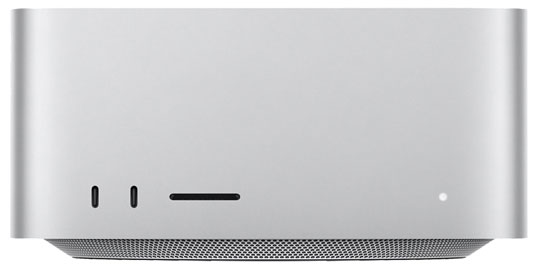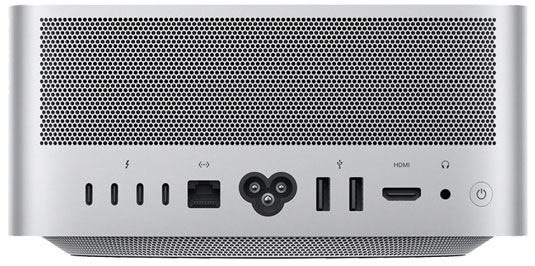Hosted by site sponsor WebMate.
Mac Studio Q&A
Published April 17, 2025
All Mac Q&As >> Mac Studio Q&A (Home)
To be notified of new Q&As, sign up for EveryMac.com's bimonthly email list.
What are all the differences between the Mac Studio "M3 Ultra/M4 Max" (2025) models? Which is best for me? Which one is actually faster?
As documented by EveryMac.com, there are two standard 2025 Mac Studio models -- the Mac Studio "M3 Ultra" 28 CPU/60 GPU and "M4 Max" 14 CPU/32 GPU -- in addition to two configure-to-order models, the Mac Studio "M3 Ultra" 32 CPU/80 GPU and "M4 Max" 16 CPU/40 GPU
Counterintuitively, the entry-level models are the "M4 Max" options and the faster, more expensive models are those with earlier generation "M3 Ultra" processors.

Photo Credit: Apple, Inc. (Mac Studio - Front)
Although these models look the same, there are significant external and internal differences between the Mac Studio M3 Ultra and Mac Studio M4 Max.
External Differences
The Mac Studio M3 Ultra and M4 Max share the same cuboid case -- 3.7 inches tall and 7.7 inches wide and 7.7 deep. However, the M3 Ultra are nearly two pounds heavier -- 8.0 pounds rather than 6.1 pounds -- because the higher performance and higher heat M3 Ultra uses a heavier copper heatsink for cooling whereas the entry-level M4 Max uses a lighter weight aluminum one.
Connectivity Differences
Connectivity is a significant difference between the Mac Studio M3 Ultra and M4 Max.

Photo Credit: Apple, Inc. (Mac Studio - Rear Ports)
The Mac Studio M3 Ultra and M4 Max have the same rear ports -- four Thunderbolt 5 ports (Up to 120 Gb/s; USB-C shaped connector), two USB-A ports, an HDMI port, a 10-Gigabit Ethernet port, and a 3.5 mm headphone jack. Both also support 802.11ax (Wi-Fi 6E) and Bluetooth 5.3.
However, the higher-end Mac Studio M3 Ultra models support as many as eight 6K displays -- or four 8K displays -- whereas the entry-level Mac Studio M4 Max models only support as many as five displays; up to four at 6K and one at 4K or two at 6K and one at 8K.
On the front, both the Mac Studio M3 Ultra and M4 Max include the same SDXC (UHS-II) card slot, but the unlabeled ports are different. The higher-end Mac Studio M3 Ultra has two much faster Thunderbolt 5 ports (up to 120 Gb/s) whereas the entry-level Mac Studio M4 Max only has two USB-C ports (up to 10 Gb/s).
Identification Differences
As diligently hand documented by EveryMac.com from the hardware itself, the 2025 Mac Studio models have both unique Model Numbers and EMC Numbers on the hardware itself as well as different Model Identifiers in software.
In recent years, the Model Number and EMC Number have not been shared by later models and these very well may be sufficient for the long-term, but shared identifiers between years always could be a possibility. In general, the Model Identifier is a more specific, long-term way to differentiate between these systems:
| Mac Studio | Model No. | EMC No. | Model ID |
| M3 Ultra | A3389 | 8859 | Mac15,14 |
| M4 Max | A3143 | 8549 | Mac16,9 |
EveryMac.com's Ultimate Mac Lookup feature can identify these models by other identifiers, as well.
More information about specific identifiers is provided in EveryMac.com's extensive Mac Identification section.
Internal Differences
Internally are the most major differences between the higher-level Mac Studio M3 Ultra and the entry-level M4 Max. Both models use highly similar internal designs, but there are a variety of different components.
The higher-end M3 Ultra models use 28-Core or 32-Core CPUs, have 60-Core or 80-Core GPUs, a 32-Core Neural Engine, 819 GB/s of memory bandwidth, and a copper heatsink. By default, they ship with 96 GB of RAM (configurable with 256 GB or 512 GB only at the time of purchase) and 1 TB of SSD storage (configurable with 2 TB, 4 TB, 8 TB, or 16 TB at the time of purchase).
The entry-level M4 Max models, by contrast, use 14-Core or 16-Core CPUs, have 32-Core or 40-Core GPUs, a 16-Core Neural Engine, 410 GB/s of memory bandwidth, and an aluminum heatsink. By default, they ship with 36 GB of RAM (configurable with 48 GB, 64 GB, or 128 GB of RAM only at the time of purchase) and 512 GB of SSD storage (configurable with 1 TB, 2 TB, 4 TB, or 8 TB at the time of purchase).
Comparison Chart
The specific differences between processors, graphics processors, configurations, connectivity, identifiers, and prices for the standard Mac Studio models are summarized below:
 Mac Studio M3 Ultra |
 Mac Studio M4 Max |
|
|---|---|---|
| Std. Processors: | 4.0 GHz M3 Ultra | 4.5 GHz M4 Max |
| CPU Cores: | 28-Cores | 14-Cores |
| GPU Cores: | 60-Cores | 32-Cores |
| Neural Engine: | 32-Core | 16-Core |
| Memory Bandwidth: | 819 GB/s | 410 GB/s |
| Heatsink: | Copper | Aluminum |
| Std. RAM: | 96 GB | 36 GB |
| Max. RAM: | 512 GB† | 128 GB† |
| Std. Storage: | 1 TB | 512 GB |
| Wi-Fi: | 6E (802.11ax) | 6E (802.11ax) |
| Thunderbolt 5: | 6 Ports | 4 Ports |
| 10-Gigabit Ethernet: | Yes | Yes |
| Display Support: | 8 | 5 |
| 8K Displays: | 4 | 1 |
| Order Number: | MU973LL/A | MU963LL/A |
| Model Number: | A3389 | A3143 |
| EMC Number: | 8859 | 8549 |
| Model Identifier: | Mac15,14 | Mac16,9 |
| Weight: | 8.0 lbs. (3.64 kg) | 6.1 lbs. (2.74 kg) |
| Intro Price (US): | US$3999 | US$1999 |
| Intro Price (CA): | C$5499 | C$2699 |
| Intro Price (UK): | £4199 | £2099 |
| Intro Price (FR): | €4999 | €2499 |
| Intro Price (AU): | A$6999 | A$3499 |
† The RAM cannot be upgraded after the initial purchase of the computer at all in any Mac Studio models.
For pricing information in dozens of other countries, refer to EveryMac.com's Global Original Prices section.
So, is a Mac Studio M3 Ultra or M4 Max best for me? Which one is actually faster?
The "2025" Mac Studio models are a bit unusual because the higher-end model -- the M3 Ultra -- uses an earlier generation processor that has twice as many CPU cores and nearly twice as many GPU cores as the entry-level M4 Max, but a 12.5% slower clockspeed.
Accordingly, the entry-level Mac Studio M4 Max actually benchmarks around 25% faster than the higher-end Mac Studio M3 Ultra in single core tasks in Geekbench 6.
Apple reports that the Mac Studio M3 Ultra "delivers nearly 2x faster performance than M4 Max in workloads that take advantage of high CPU and GPU core counts, and massive amounts of unified memory" but this is not really reflected in Geekbench 6 results. Geekbench 6 shows the higher-end Mac Studio M3 Ultra popping out about 14% more multicore performance than the entry-level option.
Benchmarks are not everything, but at twice the price, those considering the Mac Studio M3 Ultra will want to carefully evaluate the performance of their specific software needs before forking out so much more money unless the time value of money dictates that additional time saved is worth twice the price even if it is not twice as fast. The Mac Studio M3 Ultra also comes with (1) support for three more 8K displays, (2) two more Thunderbolt 5 ports, and (3) substantially more RAM and more storage by default, which are valuable, too.
For those with less demanding needs, or lower budgets, the Mac Studio M4 Max (or a Mac mini M4 Pro) should be quite sufficient.
New & Used Mac Studio Purchase Options
There are no shortage of places to buy a new Mac Studio. However, purchasing from a respected business with a solid track record in the Mac market will provide the ideal experience and save you money and time, too.
In the US, site sponsor Other World Computing sells used and refurb Mac Studio models at bargain prices with free shipping. If you need to sell a Mac Studio or just about any other recent Mac, A+ BBB-rated Cash for Your Mac will buy your older Mac with an instant quote and prompt payment.
In the UK, site sponsor Hoxton Macs sells used Mac Studio models with a one-year warranty and free next working day delivery throughout the UK.
Please also refer to EveryMac.com's Ultimate Mac Comparison feature to dynamically compare any Mac Studio to any other Mac.
Permalink | Report an Error/Typo | Sign Up for Site Update Notices
Suggest a New Q&A | Sign Up for Bimonthly Site Update Notices
<< Mac Studio Q&A (Main) | All Mac Q&As
Established in 1996, EveryMac.com has been created by experts with decades of experience with Apple hardware. EveryMac.com includes, and always has included, original research incorporating detailed, hands-on inspection of packaging, computers, and devices as well as extensive real-world use. All information is provided in good faith, but no website or person is perfect. Accordingly, EveryMac.com is provided "as is" without warranty of any kind whatsoever. EveryMac.com, and the authors thereof, shall not be held responsible or liable, under any circumstances, for any damages resulting from the use or inability to use the information within. For complete disclaimer and copyright information please read and understand the Terms of Use and the Privacy Policy before using EveryMac.com. Copying, scraping, or use of any content without expressed permission is not allowed, although links to any page are welcomed and appreciated.
